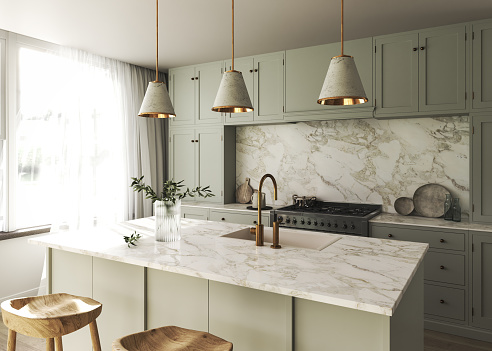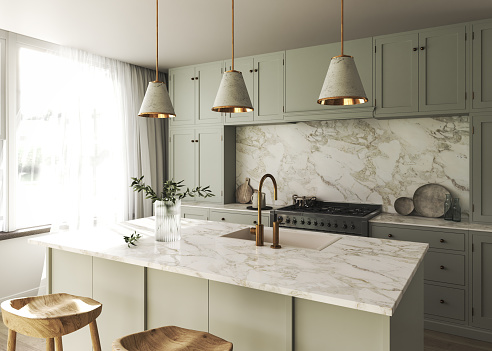Within the tapestry of home decor, the kitchen and dining areas emerge as the vibrant threads that weave functionality and aesthetic appeal. This article serves as a professional guide to the meticulous selection of kitchen and dining elements, revealing the art and science behind creating spaces that are not only culinary havens but also reflections of sophisticated design. From choosing the right kitchen layout to curating a dining ambiance, each aspect is a brushstroke in the canvas of home decor, showcasing the intersection of practicality and elegance.

- Kitchen Layouts: The Blueprint of Culinary Efficiency
The foundation of an exceptional kitchen lies in its layout—a blueprint that dictates the flow and efficiency of culinary activities. The galley layout, with its parallel counters, maximizes space and promotes a streamlined workflow. U-shaped kitchens offer ample storage and versatility, while L-shaped layouts create an open and inviting atmosphere. The island layout becomes a focal point, combining functionality with a touch of culinary theatre. Understanding the nuances of kitchen layouts empowers homeowners to tailor their culinary space to both their cooking style and the overall design aesthetic.
- Cabinet Selection: The Art of Storage Integration
Cabinetry is more than a storage solution; it is an integral element of kitchen design. Sleek, handle-less cabinets contribute to a modern, minimalist aesthetic, while shaker-style cabinets add a touch of classic elegance. Material choices, from wood veneers to high-gloss laminates, play a role in creating visual interest. The strategic integration of cabinets, balancing both form and function, ensures that the kitchen not only serves its purpose but also becomes a visual delight within the home decor ensemble.
- Countertops and Surfaces: The Intersection of Form and Function
Countertops and surfaces represent the intersection of form and function in the kitchen. Granite countertops exude luxury and durability, while quartz surfaces offer a seamless and low-maintenance option. The choice of materials extends beyond aesthetics, encompassing practical considerations such as heat resistance and ease of cleaning. The harmonious integration of countertops and surfaces into the kitchen design not only elevates visual appeal but also enhances the overall culinary experience.
- Appliance Selection: Bridging Innovation and Design
Appliances are the technological heart of the kitchen, and their selection involves a delicate balance between innovation and design. High-end, stainless steel appliances exude a professional aesthetic, while integrated appliances seamlessly blend into cabinetry for a sleek look. Smart appliances, equipped with cutting-edge technology, add a futuristic dimension to the kitchen. The careful curation of appliances ensures that they not only meet culinary needs but also contribute to the overall design coherence of the space.
- Lighting Design: Illuminating Culinary Creativity
Effective lighting design is the unsung hero of a well-curated kitchen, illuminating culinary creativity and enhancing the visual appeal. Pendant lights above the island create a focal point, while under-cabinet lighting adds both functionality and ambiance. Recessed lighting provides overall illumination, ensuring that every corner of the kitchen is well-lit. The orchestration of different lighting elements transforms the kitchen into a dynamic and inviting space, where culinary endeavors are spotlighted with precision.
- Flooring Choices: Balancing Style and Practicality
Flooring choices in the kitchen require a delicate balance between style and practicality. Hardwood floors add warmth and character, while porcelain tiles offer durability and easy maintenance. The selection of flooring materials takes into account not only the visual aesthetics but also the demands of a high-traffic culinary space. The right flooring choice becomes the groundwork for a kitchen that seamlessly integrates style with the practical demands of daily use.
- Dining Area Design: Creating a Culinary Oasis
The dining area is an extension of the kitchen—a culinary oasis where meals become shared experiences. The dining table serves as the centerpiece, and its design sets the tone for the entire space. From contemporary glass tables to rustic wooden options, the choice aligns with the overall home decor theme. Seating selections, whether sleek chairs or comfortable upholstered benches, contribute to both comfort and style. The careful integration of the dining area into the kitchen design ensures a harmonious transition from culinary preparation to shared meals.
- Dining Room Furniture: A Symphony of Elegance
Dining room furniture is a symphony of elegance that complements the culinary experience. China cabinets and buffets offer storage and display options, while sideboards add a touch of sophistication. The choice of materials, such as solid wood or glass, contributes to the overall design aesthetic. Coordinating dining room furniture with the kitchen design creates a seamless visual narrative, turning the dining area into a refined extension of the culinary space.
- Table Settings and Decor: Elevating the Dining Experience
Table settings and decor are the final strokes in creating a dining experience that transcends the ordinary. The selection of dinnerware, flatware, and glassware reflects the desired style—be it casual and eclectic or formal and refined. Centerpieces, whether floral arrangements or curated vignettes, add a touch of personality to the dining table. The strategic placement of decor elements ensures that the dining area becomes an inviting space where culinary delights are not only savored but also visually celebrated.
- Integration of Technology: Culinary Innovation in the Digital Age
The integration of technology extends beyond kitchen appliances, incorporating smart solutions that elevate culinary innovation in the digital age. Smart thermostats, automated coffee makers, and interactive recipe displays contribute to a kitchen that seamlessly blends modern convenience with culinary creativity. The strategic integration of technology ensures that the kitchen remains at the forefront of innovation, aligning with the evolving needs of contemporary living.
Conclusion
The selection of kitchen and dining elements is a meticulous dance between functionality and design—a choreography that transforms these spaces into integral components of home decor. As homeowners embark on the journey of crafting culinary havens, the careful consideration of layouts, materials, lighting, and decor elements ensures a seamless integration of form and function. The kitchen and dining areas become not only places of culinary creation and shared meals but also reflections of sophisticated design—a testament to the artistry and precision embedded in the heart of home decor.









No Comment